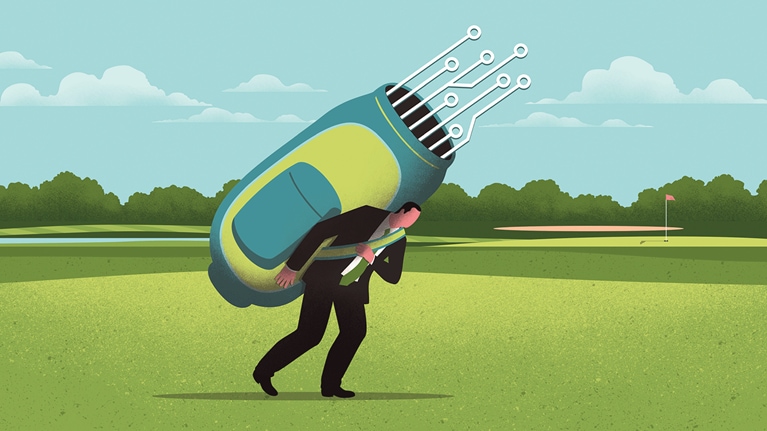For services companies, customer-facing processes are the foundation for success in critical metrics—from revenue and costs to customer and employee satisfaction. For energy providers, such as electric-power-and-natural-gas (EPNG) companies, creating a superior customer experience can increase revenue by 10 to 15 percent and decrease cost-to-serve by up to half. Furthermore, we experienced tremendous improvements in operational key performance indicators (KPIs), such as process-time reductions of 99 percent—from 19 days to less than ten minutes—also boosting customer-satisfaction indicators from five to more than 40 (that is, customer-satisfaction score).1
Stay current on your favorite topics
Today, industries everywhere are in the midst of a customer-service revolution, with technology leaders from Amazon to Uber offering one-stop digital interfaces in the palms of their hands. They are smoothly and rapidly guiding customers through any journey, from demand to fulfillment. Traditional industries such as financial services have followed, so that today, digital is the new standard for service.
Energy companies have yet to fully embrace this revolution. More than half of their customer-facing interactions happen offline, using traditional channels. Too often, they lack the capabilities and technology to adapt their customer processes—from onboarding to bill paying—to the digital world. They struggle to respond to rapid market changes and to drive lasting change across their organizations. Meanwhile, customer expectations are moving increasingly higher. For example, according to a McKinsey analysis, 75 percent of customers now expect companies to help them with any problems within five minutes, “anytime, anywhere.” Energy companies do not have time to wait for digitization, lest they be surpassed by tech-savvy upstarts who are already putting pressure on the industry.
Leading energy players have learned how other industries have digitized their processes and have started to follow their road map. They apply the same “agile” development techniques used by tech pioneers. In simple words, that means they assemble cross-functional teams with diverse skill sets, and they build processes and products gradually while receiving regular customer input along the way.
Agile may be unfamiliar to many in the EPNG world, but it is not rocket science. It is actually well suited to energy, offering a plentitude of opportunities proved by other industries that have already made successful transitions. In this report, we will talk about digitizing customer journeys, processes, and products in EPNG. We will describe an agile development methodology that works, offer some case studies of success, and provide some guidance on getting started. We call our methodology “EdgE,” for rapid, end-to-end digitization.
The challenge and the mandate for digitizing EPNG customer journeys
Anyone who has ever bought something on their phone, or used it to manage their business’s customers, has experienced a digital customer journey. Just a few examples follow:
- Amazon’s domination of the retailing world is due, at least partly, to its innovative, convenient checkout and delivery solutions, which outperform both brick-and-mortar stores and other online competitors.
- Lyft, Uber, and other online ride-hailing companies offer much greater convenience at a comparable cost than traditional taxi companies.
- On the B2B side, Salesforce.com has outperformed many established IT companies by offering its customer-relationship products innovatively as software as a service (Saas); for example, cloud-based applications.
Would you like to learn more about our Electric Power & Natural Gas Practice?
Energy companies can learn from these digital leaders and other industries, such as banking and finance, that have already undergone digitization. But, as they begin, they must accept that they have gaps to fill.
- Beyond the fact that 75 percent of customers expect help within five minutes, “anytime, anywhere,” a McKinsey analysis shows that those customers have become quite sophisticated about the interfaces they use. Fully 70 percent of customers are no longer satisfied with apps that simply have a great look and feel. They demand that those apps also have a high degree of functionality.
- Customers also use a multitude of sources to make their buying decisions. For instance, 79 percent use online reviews, and 61 percent want content customized to them, and available instantly. For energy companies, this means the need for faster speed and greater flexibility.
- Digital innovation is increasing competition in the energy space in a number of ways. New nontraditional players and start-ups have been fueled by the seamless price transparency offered by digital solutions. Today, 75 percent of consumers say they use price-comparison apps and websites when making their buying decisions.
- Some energy players may be further behind than they think. While, on average, half of customer-facing interactions still happen offline, that figure rises to more than 80 percent in some markets. Such players are particularly vulnerable to new players stealing a profitable share of their business.
If that makes the digital conversion seem particularly daunting, energy companies can, perhaps, get inspired by the benefits and the ease of implementation in using agile methods.
From paper to digital—preparing digital customer journeys
Just as digital pioneers and other traditional industries have done before them, energy companies can benefit from agile methodologies to reimagine and rapidly digitize end-to-end customer journeys, processes, and products. The agile methodology we call EdgE is particularly well-suited to EPNG.
Based on our work with several leading energy companies, we have defined a set of high-impact customer journeys for making the digital transition. To ensure success, players should start by selecting just one or two journeys to create “lighthouse” cases that will lead the way to bringing the agile approach to the organization. We have assembled these into a library of opportunities, organized into two areas—retailing and distribution:
Retail journeys
- I join: a convenient and simple way to onboard new customers
- I need help: ways to seamlessly manage customer accounts covering typical requests, such as changing payment information or adjusting advance payments
- I move: a digital way to change relevant information when moving to a new home and to make use of cross- and upselling opportunities
- I pay: ways to carry out the payment process (starting with an accurate invoice) and managing questions throughout the process
- I quit: a highly relevant and timely process to prevent customers from leaving or instantly win them back
Distribution journeys
- I connect to the grid: ways to establish a new connection to the network, either during the construction phase or when connecting a new home
- I need help: ways for customers to reach out with problems and receive qualified and instant support, from payment information to technical support
- I report my meter read: submitting a meter reading to the distribution system operator (DSo)
- I become a producer: connecting a photovoltaic system to the grid, and feeding it
How to digitize—a step-by-step approach
The agile EdgE approach follows three consecutive development steps:
- Discover: deep qualitative and quantitative analysis to generate customer insights in parallel with methodical expertise
- Design: zero-based design for each journey, rapid prototyping, and cocreation of solutions in an open collaboration space
- Deliver: creation of a minimum viable product (MVP), with just the basic necessities followed by continuous delivery

Discover (about two weeks). Companies can choose the right journeys by first focusing on what is most important to customers. By looking at use cases and underlying customer needs and pain points, they can create an evaluation of the impact potential and resource requirements for each customer journey. They can do this across multiple journeys to select which to digitize. This step gives companies an understanding of their current status, and it helps them prioritize. From our experience, the “I connect to the grid” journey is often a well-suited and high-impact starting point. Communication and skill-building are important supporting components in this step, as well as in others.
Design (about six weeks). The core of this step is to develop a concrete vision (for example, in the form of a screen flow) for the digitized end product. Designers should start from scratch (zero-based) and ensure that they meet the requirements of both today’s and tomorrow’s customers. To do this, many teams conduct an “agile hackathon” (an experience-ideation workshop) that includes customers to help facilitate the design (Exhibit 2).

The hackathon typically takes one to two days and follows three principles to instantly generate effective end products:
- Characteristics of this methodology include first throwing out all previous processes. Teams are recruited by ensuring representation of all involved stakeholders, particularly customers. Teams clearly define the problem to be solved, down to its root causes. They consider and test multiple options, and finally pick a winner.
- Teams use rapid prototyping (they create an early version of a product) to allow for fast and concrete design iterations with relevant stakeholders and to have an end-product focus.
- It is important to collect and understand underlying customer insights (ideally prior to the hackathon) and to prepare “mood curves” to illustrate customer emotions following the full journey. During the hackathon, teams implement direct customer testing to collect live feedback for on-the-spot improvements.
The end product of a hackathon is to have a concrete vision of the MVP. For energy companies, this can be, for example, a digitized customer-facing process that covers the basic necessities, which teams build upon later. Teams also develop an initial hypothesis for the scope of the entire process, including key challenges for implementation.
Fundamental to the success of this step is ensuring that everyone on the team understands the underlying customer-facing process. Working hand in hand with customer research, the team should define and describe the characteristics of typical customer segments that they need to address in the new journey. Typically, this is done through ethnographic research, where the service designers spend time with customers to observe their “daily life.” This is the best approach to uncover latent needs and pain points. We call these segments “personas,” to bring them to life for all participants.
Beyond the hackathon, this phase includes further testing, iterations with customers, quantification of required staff capacity, and detailing the future end product—all performed in an iterative, fast-paced process.
Deliver (about 12 weeks, and ongoing). Experience has shown that developing MVPs is key to success. This means building a product (or, a customer process) with core functions first—just enough to resonate with customers—and then testing with customers, before gradually adding new functions. This is in contrast to the more traditional stage-gate waterfall software-development process, which attempts to create a complete product with all functionalities. Metaphorically, it means that rather than inventing the iconic Swiss Army knife, with all the add-ons and functionalities, in one go, teams initially develop and test only the knife before gradually appending additional tools (Exhibit 3).

As a result of the MVP process, traditional organizations now manage to deliver an 80/20 solution efficiently and quickly. This solution then forms the basis for further customer testing, refinement, and delivery of the extended and customer-focused product (or process). A few elements in this step are worth mentioning:
- The initial MVP must not cover 100 percent of the fully extended product, to allow for an initial and timely “go live” that is subject to further customer-based iterations and refinement.
- While teams should clearly define the scope of their end product, they should build it gradually via the MVP road map. This includes creating user “stories,” or brief narrative descriptions of a function from the user’s perspective, and “epics,” which are longer stories describing bigger functions. If multiple teams are working on a single product or process, someone takes responsibility for harmonizing their work. In addition, teams keep a detailed backlog (that is, a to-do list of functions to be developed), ensuring they stay focused on customers.
- Teams hold weekly check-in meetings to update the broad development scope, along with daily iterations in the form of brief “stand-up” meetings that enable instant iterations and clearing of roadblocks. During the stand-up meetings, product owners present their latest development tasks, next steps, and potential roadblocks. This allows for instant problem solving and cross-team alignment, if required.
- During the development process, the team can be gradually refined as the scope of the journey increases. The team should include a well-balanced mix of agile roles, including a product owner, who represents the business and users; a “scrum master,” who runs the project team; and solution architects, who drive the technical direction (see sidebar, “Agile development definitions”).
- Teams should also ensure that members build their agile capabilities along the way. The ideal team includes people with profound experience, along with those who are new to agile methodology but highly motivated. A combination of on-the-job learning and dedicated training sessions for less experienced people is most effective and creates momentum to spread the methodology beyond each individual project.
Once the MVP goes live, the process of scaling up should begin, but gradually. Teams often limit the initial rollout to a specific region as a pilot test and to gain experience in the field, including more customer feedback. After a successful pilot, teams roll out further, along two dimensions: first, they extend the process’s scope and functionality within the pilot region, to gain more experience, and second, they roll out the initial MVP in other regions. Sometimes, it is essential to make slight regional adjustments, such as region-specific branding, potentially requiring additional development resources. Eventually, teams roll out the entire process across all regions.
It is important that before ramp-up occurs companies ensure they integrate the new regional stakeholders into the rollout preparation, and train them to handle the new process. As new teams hit the ground for rollouts, they require coaching and training sessions (for example, in-person training and video-enabled training). They also need support, such as handbooks, answers to frequently asked questions, and helpdesk assistance. By following the train-the-trainer principle, companies can ensure that more and more people throughout the organization become ambassadors for agile development, anchoring this new way of working across all regions.
Finally, companies should follow a standardized approach to tracking success, using a comprehensive dashboard that covers all relevant measures, such as customer satisfaction, process time, and process quality.
As companies consider embarking on such transformations, it is important to note some prerequisites to success, particularly as they relate to the technology infrastructure and to internal company processes. On the infrastructure side, companies need to build the necessary applications and systems and ensure access to required data across stakeholders (for example, local data storage may no longer suffice). On the internal company-process side, companies need ways to ensure the smooth transfer of information and automated alignment among stakeholders.
Case studies demonstrating success
To better demonstrate how agile methodology works, we provide case studies for two customer journeys at a major European EPNG player: “I connect,” and “I move.” Both are major drivers of customer satisfaction and profit for the company—and so were among the first selected for digitization.
I connect
I connect redesigned the grid-connection-ordering process for site electricity, that is, electricity during the construction phase—as well as electricity and gas for residential homes and small and medium-size enterprises (SMEs). The company took this process from one that was highly manual and paper based to a user-friendly, integrated, and digital journey.
Initial situation. Before the redesign, connecting to the grid was a cumbersome process, including more than 70 pages of paperwork and eight approval signatures. It caused inconvenience for customers, company technicians and back-office staff, and construction partners. Customers often strained to fill out the raft of required technical details. There was little alignment of the process interdependencies across customers, installers, technicians, and back-office administrators. This caused substantial rework and back-and-forth steps among the stakeholders.
Agile approach. First, designers mapped the current process, understanding all pain points and interdependencies among the stakeholders. Five scrum teams were established to create the MVP, covering the customer interface, the administrative interface for employees who receive customer requests, the installer tool, and technical solutions, as well as an implementation team to support business units as they phased out the former process and phased in the digital one.
Teams took particular care to ensure back-end integration, as communication was crucial for success. Here, the daily stand-up meetings proved vital to instantly align teams and to solve unforeseen problems smoothly and effectively. The MVP covered just electricity products for private customers. It was rolled out in two regions as a pilot. As described before, scaling took place along two dimensions: a gradual increase of the product scope (that is, gas and SMEs) in the pilot regions and—in parallel—ramping up the MVP in additional regions. During the rollout process, participants received intensive training, detailed instructions, and FAQs, along with a 24-hour emergency service line for urgent requests.

Subscribe to the Shortlist
Impact. The impact was tremendous. The digitized solution eliminated exhausting paperwork and cut the number of signatures down to one (which was still required due to regulations). Customers can now order a new grid connection in less than ten minutes. An administrator automatically receives all required information electronically. If additional information is required, such as specifications, that person can do so with one click. The administrator can then forward the comprehensive package to a preferred installer, who can accept it, and edit it if necessary, using a mobile device anytime and anywhere. Scheduling and process updates happen automatically and keep all relevant parties updated (Exhibit 4).

Overall customer satisfaction, measured by the customer-satisfaction score, rose from five to more than 40. Process time fell by 99 percent, and the delivery failure rate decreased by more than 75 percent. Beyond these customer-related KPIs, administrative effort was reduced by more than 50 percent. In addition, the company can now take advantage of new cross-selling opportunities, thanks to the integration of sales points into the customer journey. The team setup included experienced agile practitioners as well as rookies, allowing for knowledge transfer around the organization and preparing the company to digitize other customer journeys.
I move
The EPNG company decided to prioritize “I move” because it was losing roughly 80 percent of its customers during their process of moving to a new home. In order to increase customer retention, the company focused on the customer’s point of view and simplified the process of keeping an existing contract when moving houses.
Initial situation. Prior to customer-centric digitization, the company had undertaken several initiatives to improve its performance in this area, but none showed lasting impact since they did not reflect the underlying customer needs. The previously designed online solution was complex and incomprehensible for most customers, forcing them to either call the service hotline or to simply end the contract. When moving to a new home, customers are largely occupied with myriad tasks, but electricity is not a priority. Thus, the key to retaining customers is to reduce organizational effort to an absolute minimum by providing a simple “anytime, anywhere” solution. By alleviating complexity, most customers are prone to keep their contract and shy away from the time and effort to compare energy providers.
Agile approach. During design, the team identified one of the major pain points: a complex, paper-based process with several manual iterations and limited transparency across stakeholders. The company decided to implement a chat-bot—a concept that was fundamentally novel and a rethinking of the customer-interaction model. In close cooperation with customers, interdisciplinary teams created a new front-end interface for customers that was straightforward, simple, and easy to process. It collected all the data required, including the move-out date, meter reading, and forwarding address. This was combined with smooth back-end integration to speed up and simplify the process. As a result, the time to complete the moving process was reduced from several days to less than five minutes. Another factor of success was to involve regulation as part of the solution: regulatory experts were involved early on to ensure regulatory conformity during development. On closer analysis, the regulatory constraints as limiting factor were less severe than often thought. A clear road map helped all parties keep track of the process status, improving convenience and increasing trust. As before, keys to success included early integration of all relevant stakeholders and customer testing of the solutions right from the start.
Impact. Not only was the customer churn rate reduced by more than 30 percent but digitization also freed up staff capacity, allowing people to focus more time on customer requests and less on process handling. As a consequence, cost-to-serve was reduced by 20 to 30 percent (Exhibit 5).

How to get started tomorrow
Digitizing customer journeys based on the agile methodology is a radical approach, particularly as it requires an entirely new way of thinking about solution design. Rather than creating solutions with all possible functionalities in a lengthy process, teams create MVPs, and then develop them further, through continuous testing with real customers who give real-time feedback. The approach improves the satisfaction of customers, employees, and business partners, while simultaneously reducing staffing requirements and development risks (Exhibit 6).

With start-ups and new entrants in the EPNG market enhancing customer satisfaction through digital solutions, we believe it is time for incumbents to respond, becoming the new thought leaders and innovators in creating easy, fast, and seamless digital customer journeys.


